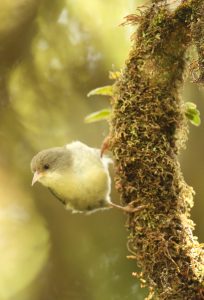The Last ‘Akikiki
PAYING HOMAGE TO THE LAST ‘AKIKIKI IN THE WILD
Dr. Lisa “Cali” Crampton was featured on KITV, after the following DLNR press release was by Dan Dennison:
When a group of men hiked into a remote mountain valley in April, they knew it could be the last time they saw an ‘akikiki in the wild.
“This was kind of a trip to say goodbye. ‘Akikiki are down to at most, a handful of individuals, maybe even fewer,” said Justin Hite, a longtime field supervisor for the Kaua‘i Forest Bird Recovery Project (KFBRP), now working on mosquito control planning with the DLNR Division of Forestry and Wildlife.
“What do you do at the end of a species? They don’t take any solace from us coming to visit. It was much more about us wanting to be able to say goodbye and to get around them one last time,” Hite added.
Once numbering in the thousands in the stunning valleys and ridges of native forest, their decline in recent years has been predicted and precipitous.
Just when the broad collaboration of government agencies, nonprofits, and countless individuals seemed to be making inroads in protecting the birds from predators like cats and rats, avian malaria upset the equation. Global warming has forced disease-carrying mosquitoes to the higher elevation habitats of the ‘akikiki and other Hawaiian honeycreepers. One by one the deadly disease has picked them off.
“That is the tragedy, right?” asks Dr. Lisa “Cali” Crampton of the KFBRP. “We are seeing this climate disaster, so I apologize (to the ‘akikiki) for what we have done as people. I do want the ‘akikiki to know that we really appreciated getting to know them. You know, were it not for this crisis, I don’t think people would have gotten to know ‘akikiki as well as we have and come to love them as well as we have.”
Their plight has reached far and wide. School children in India named an asteroid after ‘akikiki.
During the recent trip, the team kept an eye out for one female bird, named Pakele. Hite said, “We met her in 2020 and she was exceptional from the start.” In Hawaiian, Pakele means to escape. Three seasons in a row she had successful nests, possibly while being infected with malaria. “She’s like, it doesn’t affect me. She’s kind of this incredible individual.”
For more than a decade, field teams forged personal connections with the birds by naming them and instantly knowing who they were from their multi-colored leg bands.
“This is much harder to talk about than I thought it was going to be. Just recapturing the emotions that we felt, as we know these birds. In my case I spent ten breeding seasons up on the Alaka‘i,” Hite added.
The spiritual connection, as Crampton describes it, is one layer of the extinction of the ‘akikiki. “That’s represented now by one bird like Pakele still being out in the wild. That’s enormously important to my staff. I think it’s enormously important to the public and to cultural practitioners who look at Pakele as representing the hope we have, because she just keeps going. Hopefully she’ll find a mate. Even though they cannot sustain a wild population, they can sustain our hope and that’s critical at this juncture.”
Despite the existence of one, two, or three birds remaining in the wild, the species is considered functionally extinct. The best and only chance for a viable future lies with captive ‘akikiki at bird conservation centers operated by San Diego Zoo Wildlife Alliance. Perhaps one day, after the threat of avian malaria is stamped out, ‘akikiki can be released back into the high plateau, mountains, and deep valleys of Kaua‘i.
“We did our best, given our knowledge and the available science,” Crampton said. “I want us to understand that we’re all in this together. The fate of all these species is collectively the responsibility of humans everywhere in this world. It is our actions that have led to the situation our planet is in. I’d like everyone to just champion the environment wherever they are.”







 Robby Kohley
Robby Kohley






